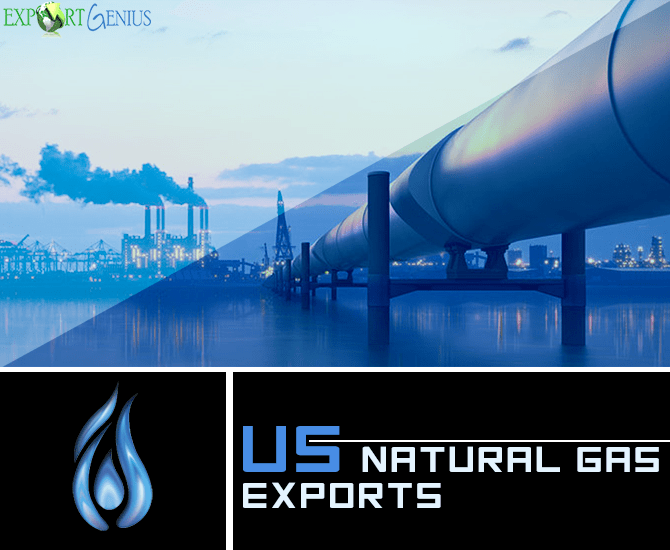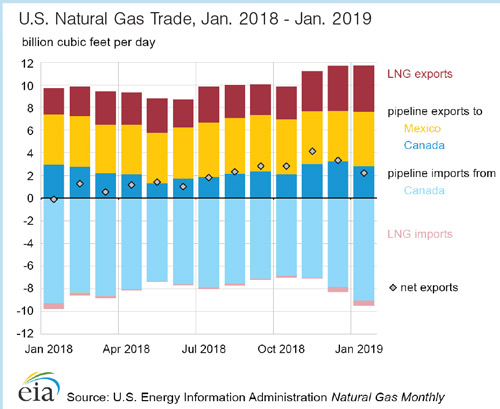

In this case, both net LNG and net pipeline exports in 2040 are higher than in any other AEO2015 case, because higher production capability lowers the cost of U.S. Natural gas net exports are highest in the High Oil and Gas Resource case, which assumes both higher resources and improvements in technology to bring those resources to market. More than half of the increase in shale gas production comes from the Haynesville and Marcellus formations.

Increased shale gas production accounts for three-quarters of the increase in total dry gas production. net natural gas exports occurs before 2030, as increased domestic natural gas supply satisfies new demand both internationally (with the development of LNG export capacity and growing demand for pipeline exports) and domestically (particularly in the industrial and electric power sectors). For comparison, 2040 natural gas net exports by pipeline range from 1.1 Tcf in the High Oil Price case to 2.9 Tcf in the High Oil and Gas Resource case. By 2040, LNG exports range from 0.2 trillion cubic feet (Tcf) in the Low Oil Price case to 10.3 Tcf in the High Oil and Gas Resource case. Net LNG exports make up most of the natural gas exports in most cases. These assumptions significantly affect projected growth in annual net LNG exports after 2017. The AEO2015 examines alternate cases with higher and lower world oil price assumptions, which serve as a proxy for broader world energy prices given oil-indexed contracts, as well as with higher assumed U.S. natural gas and world prices that encourages exports of liquefied natural gas (LNG), and, to a lesser extent, greater exports by pipeline to Mexico. Increased availability of domestic gas or higher world energy prices each increase the gap between the cost of U.S. After 2017, natural gas trade is driven largely by the availability of natural gas resources and by world energy prices. In its recently released Annual Energy Outlook 2015 (AEO2015), EIA expects the United States to be a net natural gas exporter by 2017. Given China’s expected decline in domestic crude oil production, imports will likely continue to increase over at least the next two years.Republished April 28, 2015, 11:00 a.m., to correct an error in the text. According to trade press reports, as much as 1.4 million b/d of new refinery capacity is planned to open in China by the end of 2019. In January 2018, China and Russia began operating an expansion of the East Siberia-Pacific Ocean (ESPO) pipeline, doubling its delivery capacity to approximately 0.6 million b/d. Ongoing infrastructure expansions will likely contribute to further increases in China’s crude oil imports. The China National Offshore Oil Corporation’s (CNOOC) Huizhou refinery increased capacity by 200,000 b/d and increased its imports from various sources in the third and fourth quarters of 2017. A 260,000 b/d refinery in Anning in Yunnan province started operating in the third quarter of 2017. China’s refinery runs increased by an estimated 0.5 million b/d in 2017 to 11.4 million b/d, driven in part by two refinery expansions in the second half of the year. Since mid-2015, China granted crude oil import licenses to independent refineries in northeast China, which have since increased refinery utilization and crude oil imports.Ĭhina’s crude oil imports have also increased because of higher refinery runs and expanding refinery capacity.

In addition, China has reformed its refining sector by reducing restrictions on both imports and exports. As China has built up inventories of strategic petroleum reserves, China’s crude oil imports have increased faster than their domestic consumption. In contrast to declining domestic production, EIA estimates that growth in China's consumption of petroleum and other liquid fuels in 2017 was the world’s largest for the ninth consecutive year, growing 0.4 million b/d (3%) to 13.2 million b/d. Total liquids production in China averaged 4.8 million b/d in 2017, a year-over-year decline of 0.1 million b/d (2%) from 2016, and further declines in both 20 are forecasted in EIA’s January 2018 Short-Term Energy Outlook (STEO). China had the largest decline in domestic petroleum and other liquids production among non-OPEC countries in 2016, and EIA estimates it will have had the second-largest decline in 2017. Several factors are driving the increase in China’s crude oil imports. Source: China General Administration of Customs, based on Bloomberg, L.P


 0 kommentar(er)
0 kommentar(er)
